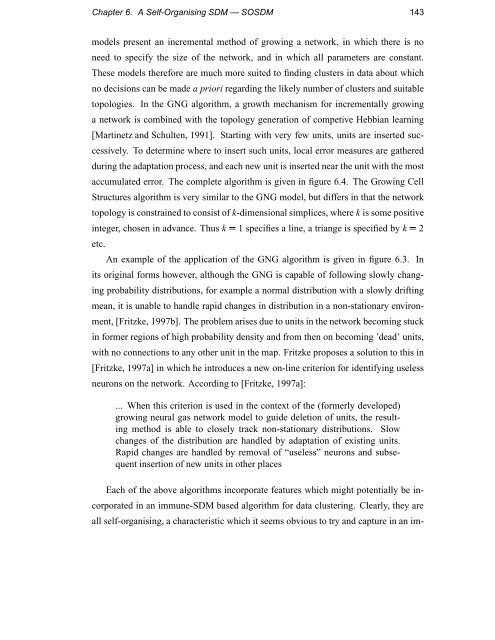Immunology as a Metaphor for Computational ... - Napier University
Immunology as a Metaphor for Computational ... - Napier University
Immunology as a Metaphor for Computational ... - Napier University
You also want an ePaper? Increase the reach of your titles
YUMPU automatically turns print PDFs into web optimized ePapers that Google loves.
Chapter 6. A Self-Organising SDM — SOSDM 143models present an incremental method of growing a network, in which there is noneed to specify the size of the network, and in which all parameters are constant.These models there<strong>for</strong>e are much more suited to finding clusters in data about whichno decisions can be made a priori regarding the likely number of clusters and suitabletopologies. In the GNG algorithm, a growth mechanism <strong>for</strong> incrementally growinga network is combined with the topology generation of competive Hebbian learning[Martinetz and Schulten, 1991]. Starting with very few units, units are inserted successively.To determine where to insert such units, local error me<strong>as</strong>ures are gatheredduring the adaptation process, and each new unit is inserted near the unit with the mostaccumulated error. The complete algorithm is given in figure 6.4. The Growing CellStructures algorithm is very similar to the GNG model, but differs in that the networktopology is constrained to consist of k-dimensional simplices, where k is some positiveinteger, chosen in advance. Thus k 1 specifies a line, a triange is specified by k 2etc.An example of the application of the GNG algorithm is given in figure 6.3. Inits original <strong>for</strong>ms however, although the GNG is capable of following slowly changingprobability distributions, <strong>for</strong> example a normal distribution with a slowly driftingmean, it is unable to handle rapid changes in distribution in a non-stationary environment,[Fritzke, 1997b]. The problem arises due to units in the network becoming stuckin <strong>for</strong>mer regions of high probability density and from then on becoming ’dead’ units,with no connections to any other unit in the map. Fritzke proposes a solution to this in[Fritzke, 1997a] in which he introduces a new on-line criterion <strong>for</strong> identifying uselessneurons on the network. According to [Fritzke, 1997a]:... When this criterion is used in the context of the (<strong>for</strong>merly developed)growing neural g<strong>as</strong> network model to guide deletion of units, the resultingmethod is able to closely track non-stationary distributions. Slowchanges of the distribution are handled by adaptation of existing units.Rapid changes are handled by removal of “useless” neurons and subsequentinsertion of new units in other placesEach of the above algorithms incorporate features which might potentially be incorporatedin an immune-SDM b<strong>as</strong>ed algorithm <strong>for</strong> data clustering. Clearly, they areall self-organising, a characteristic which it seems obvious to try and capture in an im-









![Unit 5. Switches and VLANs [PDF]](https://img.yumpu.com/34422504/1/184x260/unit-5-switches-and-vlans-pdf.jpg?quality=85)






